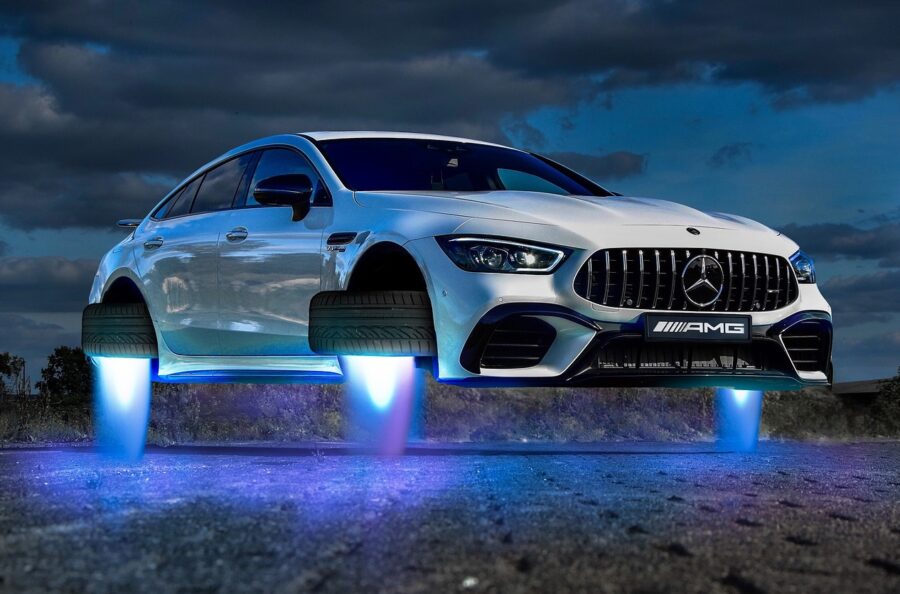See Two Flying Cars Drag Race Through The Skies
See two flying cars drag racing across the sky. It very much looks like the future is now. Could these be the next wave of transportation
This article is more than 2 years old

Airspeeders recently launched a preseason test run of its unmanned Mk3 multirotor Speeders ahead of next year’s EXA Drag Race and the results are glorious. Flying cars have never looked cooler. Now there’s a chance to see a couple of them speeding across the sky in futuristically glorious fashion.
Airspeeders just applied the finishing touches on its first working prototype of a clean-air electric vehicle (EV) or flying car. They are part of a long line of quadcopters utilizing remotely piloted aircraft systems (RPAS) and were proudly tested out against the harsh, but tantalizing, backdrop of the Flinders Range in South Australia. It’s the largest mountain range in the region, beloved for scenic hiking routes and heavily forested ridgetops. Check out the video of the race.
It was the perfect site for a flying car of Airspeeders’ propulsive power. Two Mk3 Speeders, Team Alpha and Team Bravo, ran a 300-meter virtual drag strip suspended 15 meters above the ground, with elite test pilots manning the controls. Bravo emerged victorious. It was a groundbreaking first race signifying the greater technological strides to come.
Founded by tech mogul Matt Pearson, Airspeeders specializes in remotely piloted quadcopters capable of seamless vertical take-off and landing (VTOL). Capable of speeds up to 200 kilometers per hour, these electric flying cars are developed by Alauda Aeronautics for use in competitive motorsport. Also dubbed Airspeeders, the Adelaide-based advanced engineering company’s upcoming next-generation air racing series pits drone racing champions against each other in high-octane aerial battles to determine the full range of Alauda’s Mk3 multirotor crafts. GQ described the concept of electric flying cars as revolutionary, a quintessential “Formula 1 of the skies.” Contestants will be carefully selected based on their flying backgrounds and can originate from various connecting fields, including commercial aviation, private and test piloting, military Fighter Jet experience, and motor racing. Only VIPs are permitted to watch the matches.
Airspeeders believes mankind is in the throes of a mobility revolution, where electric flying cars replace standard vehicles running on fossil fuel in a collective bid to fight pollution, reduce carbon emissions, and assist in high-stakes medical missions. Urban air mobility (UAM) is the impending future of private and public transport, with several personal air vehicles (PAVs) already in active development.
Aside from Speeders, Airbus Helicopters has launched the CityAirbus project. Germany’s Lilium GmbH recently manufactured a prototype five-seat eVTOL (electric VTOL) airplane, the Lilium Jet, meant for an upcoming air taxi service. Alexander Zosel and Stephan Wolf have privately funded Volocopter for the same purpose as the Lilium Jet. Guangzhou EHang Intelligent Technology’s EHang 216 was also announced alongside the highly experimental Boeing Passenger Air Vehicle, a cross between a drone and a helicopter intended for privatized use. There’s no denying every tech entrepreneur worth their salt is into flying cars.
The Mk3 Speeders were designed by Alauda Aeronautics to resemble first-person view (FPV) drones, modern-day aircrafts, electric cars, and passenger drones, taking the best out of each industry into a cohesive, efficient new whole. A different caliber of flying car nobody has seen before.
These nifty flying cars employ the latest in advanced air mobility (AAV) technology, and are outfitted with LiDAR radar sensors and powerful electronic force fields — all adapted to match the Speeders’ tiltrotor multicopter build. Mk3 takes advantage of this cutting-edge new layout to maximize stability in tune with electronic speed control (ESC), a special circuit built to regulate electric motors. Most radio-controlled models are capable of reverse flight and dynamic braking, among others. Together, these features combine to give pilots extensive control over Mk3’s full potential, resulting in an unmarred travel experience worth spending big bucks over.
Season Alpha of Airspeeders is scheduled to begin sometime next year. The tech company is already simulating real-world racetracks using the Mk3 flying cars across Coober Pedy, South Australia. Mk4 is already close to completion.












